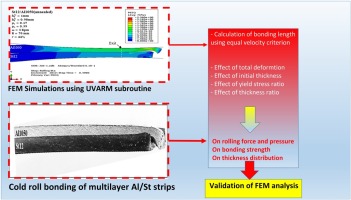Journal of Manufacturing Processes ( IF 6.1 ) Pub Date : 2020-03-05 , DOI: 10.1016/j.jmapro.2020.02.044 A. Rezaii , E. Shafiei , F. Ostovan , H. Daneshmanesh

|
In the present study, cold roll bonding process of dissimilar bimetal strips of steel/Al was simulated and investigated using finite element method. To this end, velocity variable was introduced to ABAQUS using UVARM subroutine. Accordingly, prediction of the starting bonding point by the finite element method, based on the criterion of equal velocities of the layers, was in good agreement with the experimental results. In the process of roll bonding of bimetal steel/aluminum strips, the effect of some factors on the bonding strength including the total deformation of the strip, the initial thickness of the strip, the yield stress ratio and the thickness ratio of the layers were studied. In addition, the deformation of each of the steel and the aluminum layers were also investigated during the rolling. The results of finite element simulations, as well as the experimental results, showed that with increasing the total deformation percentage of the strip, the rolling force, the mean pressure at the interface of the layers, the deformation percentage of each layer and the relative bonding length increase. Furthermore, it was found out that increasing the yield strength ratio of the aluminum layer to the steel layer at a certain total deformation percentage of the strip, on one hand, increased the rolling force, the mean pressure at the interface of the layers as well as the relative bonding length and on the other hand, decreased the non-homogeneity in the deformation of the layers. Further studies revealed that decreasing the initial strip thickness at a certain total deformation percentage of the strip reduced the rolling force as well as the non-homogeneity in the deformation of the layers. But it increased the mean pressure at the interface of the layers as well as the relative bonding length. In this regard, the unprecedented consistency of the theoretical and experimental results indicated an appropriate accuracy of the presented finite element analysis in analyzing the cold roll bonding process.
中文翻译:

多层条带轧制过程的有限元实验与理论研究
在本研究中,使用有限元方法模拟并研究了钢/铝异种双金属条的冷轧结合过程。为此,使用UVARM子例程将速度变量引入ABAQUS。因此,基于层的等速准则,通过有限元法对起始结合点的预测与实验结果吻合良好。在双金属钢/铝带材的辊轧粘合过程中,研究了一些因素对粘合强度的影响,包括带材的总变形,带材的初始厚度,屈服应力比和层的厚度比。 。另外,还在轧制过程中研究了钢层和铝层的变形。有限元模拟的结果,实验结果表明,随着带钢总变形率的增加,轧制力,各层界面处的平均压力,各层的变形率和相对粘结长度都增加。此外,发现在带材的一定总变形百分数下增加铝层与钢层的屈服强度比,一方面增加了轧制力,也增加了各层界面处的平均压力。另一方面,随着相对粘合长度的增加,层的变形的非均匀性降低。进一步的研究表明,在一定的条带总变形百分比下减小初始条带厚度会降低轧制力以及各层变形的不均匀性。但是,这增加了层界面的平均压力以及相对的粘结长度。在这方面,理论和实验结果空前的一致性表明,所提出的有限元分析在分析冷轧粘结过程中具有适当的准确性。











































 京公网安备 11010802027423号
京公网安备 11010802027423号